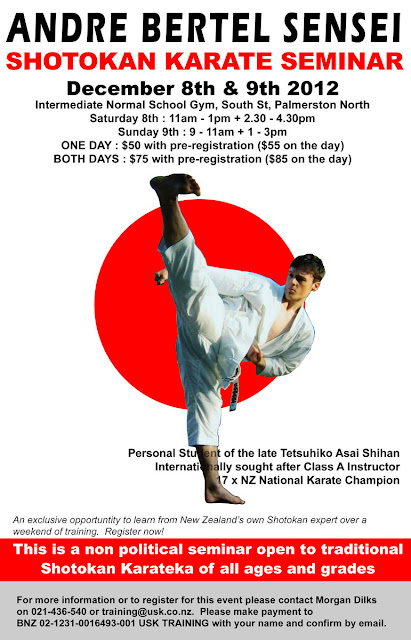In this post I want to address three things that probably
need some confirmation, based on some misunderstandings about Tetsuhiko Asai
Sensei’s karate that I practice, and instruct, globally.
Firstly, an explanation of muchiken (whip fist) techniques;
secondly, why in drills I often have my uke attack with oi-zuki; and thirdly, kime.
(1)
MUCHIKEN: Contrary to the views of Canadian
gentleman commenting on/closely following my international karate career, Muchiken-waza
is not just a slap, although it can be with devastating results. Foremostly,
muchiken is about learning to fully relax in karate techniques. By practising
muchiken we not only improve circular techniques, but also our core Shotokan punches:
namely, oi-zuki, gyaku-zuki and kizami-zuki. Not to mention ukewaza, keriwaza
and most obviously, uchiwaza. When you see me demonstrate muchiken-waza at chudan
level, it is for safe practise. This is the safest way to practise with a
partner without holding back too much. Nevertheless, the Canadian chaps thoughts were totally understandable and utterly logical, which I like to see; hence, this explanation.
Interestingly, every country I have taught
seminars in: Japan, USA, Australia, Italy, Germany, New Zealand, England etc...,
have been shocked by the immense power that can be generated from proper
muchiken. It really has to be
experienced to be believed. When I worked in the security industry, I had the
chance to apply these waza... No need to say more.
(2)
OI-ZUKI: When demonstrating in seminars I often
have my uke (receivers) attack with oi-zuki. Many people denounce this… They say
“no one attacks with oi-zuki in a real fight”… This is funny for me as a person
who worked in the security industry for many years and had numerous
altercations. Maybe they think I don’t know this?
Explanation: The purpose of oi-zuki in `open seminars’ is
to allow those participating to `cleanly’ see the technique I am teaching. You have to remember the teaching context! My
seminars are to improve people’s karate... Not bash up people. Of course, this
is basic training. Consider military training with rubber bullets as opposed to
the real thing. We move on from there with hooks, uppercuts, grappling and so forth. If we did that from the beginning, there would only be a blur.
(3)
KIME: On my recent course in England, it was
said that I don’t teach or believe in kime… Well, that is wrong. I teach to
eradicate `incorrect kime’ according to Asai Sensei; that is, tensing the muscles for a fraction of a
moment at the end of techniques. Asai Sensei ‘s Kime is about `decisiveness’.
I.e. – the target, depth of impact etc… This was his view, and therefore, the karate that I
teach. I’m not claiming this is the only way; it is merely the tradition I am
keeping alive. Please don’t think André Bertel thinks “it’s my way or the
highway”… I am merely teaching what Sensei Asai taught me. I’m only one guy... If you like what I teach adopt it, otherwise disregard it. The reality is that my karate is for small people or those with very limited strength. If I was big and strong, perhaps I would do karate very differently...
Lastly, I would like to say that I don’t believe anyone has
all the answers in karate-do, naturally, myself included. I simply keep on the
straight line of practising and teaching IJKA karate (Asai-ha Shotokan-ryu) as
my late teacher Tetsuhiko Asai asked me to do before he passed away. If you don’t
understand this, please read his final interview in English (which he had me
conduct): http://andrebertel.blogspot.co.nz/2008/12/asai-senseis-final-international.html
© André Bertel.
Christchurch, New Zealand (2012).































.JPG)




















